Low light binoculars to explore in the darkness
Low light binoculars are an integral part of outdoor equipment for hunters, outdoor enthusiasts and nature lovers.
Usually sunrise or sunset is the best time to observe animals. However, natural light at this time makes clear vision almost impossible. Such binoculars increase both ambient light and the photo, providing a clear sightline in low light conditions.
Low light binoculars are also used by trail hikers. They need such devices when walking through thick forests, dark trails and rocky caves.
When choosing good low light binoculars, you need to take into consideration some important factors like the field of view or how much area you can see, magnification and objective lens diameter.
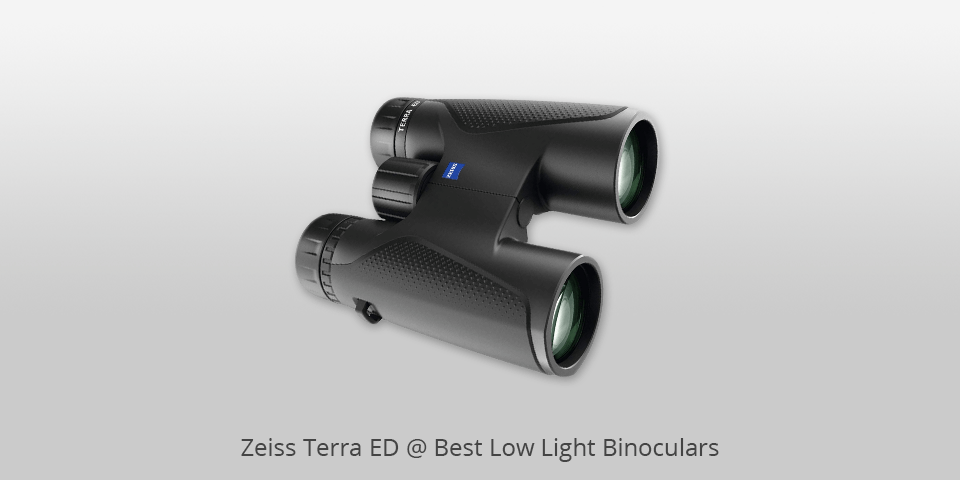
Magnification: 8x | Objective diameter: 42mm | Field of view at 1000m: 331 ft | Closest focusing distance: 5.25 ft | Eye relief: 14 mm | Weight: 24.5 oz
⊕ Solid case
⊕ Great distortion correction
⊕ Moderate loss of brightness at the edge
⊕ Small flares
⊖ Slightly high coma level
⊖ Standard sharpness at the edge of the field of view
Zeiss Terra ED low light binoculars are portable, lightweight and powerful. They can fit into any bag and are almost unbreakable. Due to their fiberglass-reinforced waterproof case, they are ideal for bad weather conditions.
Thanks to a big, seamless and easy-to-grip focus wheel, these binoculars provide an easy focus. Also, these binoculars have SCHOTT ED glass with a hydrophobic multi-coating, which provide great optical precision. True nature lovers will definitely love them!
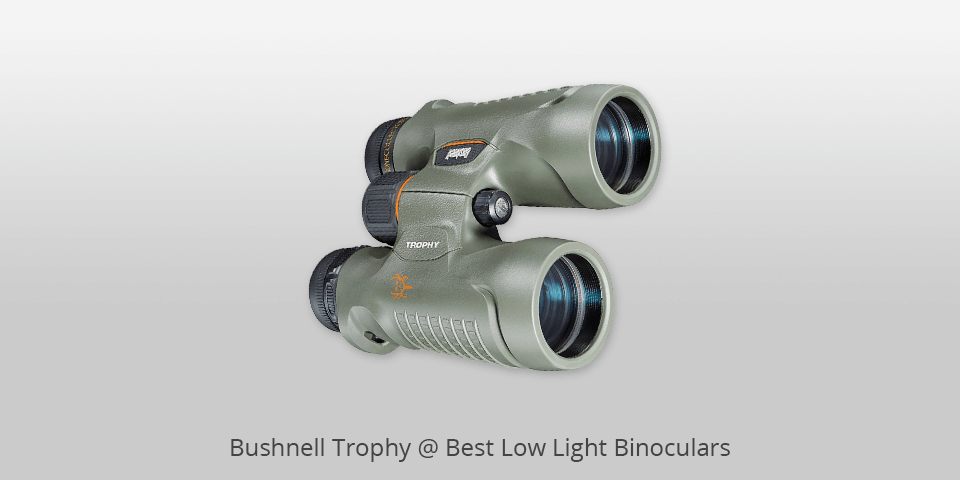
Magnification: 10x | Objective diameter: 42mm | Field of view at 1000m: 325ft | Closest focusing distance: 8.2 ft | Eye relief: 15.22mm | Weight: 25 ouncees
⊕ Weatherproof
⊕ Inexpensive
⊕ Have an adaptable tripod
⊕ Dura-Grip rubber covering
⊖ Not the best focus
Bushnell Trophy binoculars provide amazing hunting performance and clear viewing. These are the best low light binoculars as they are waterproof, fog-proof, armor-plated, guarantee top-grade durability and clarity even in the worst weather conditions.
These aggressive, ergonomic binoculars have multi-coated lenses with new lens covers that always remain in their place. They are also equipped with 2-Step eyecups for better fit and comfort.
These low light binoculars are ideal for serious hunters who want to get stunning images without spending too much money on binoculars. Also, these binoculars come with a lifetime warranty.
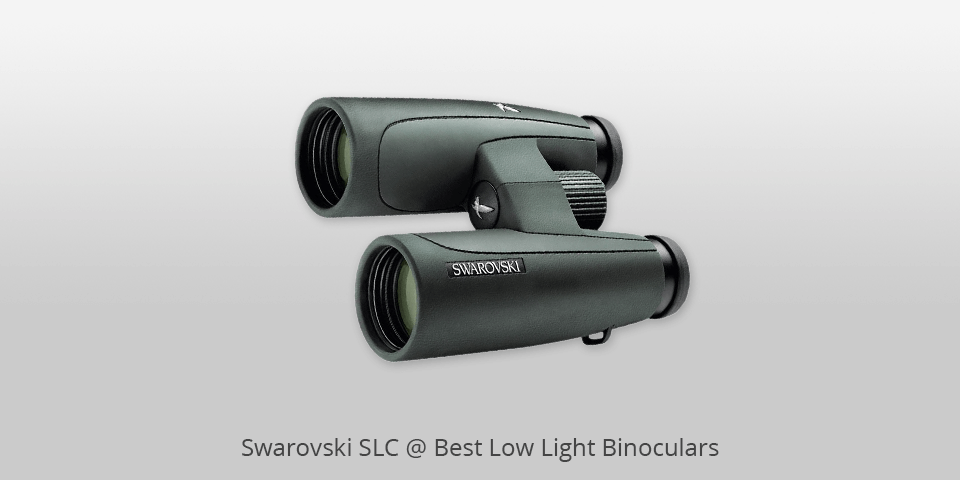
Magnification: 10x | Objective diameter: 42mm | Field of view at 1000m: 330ft | Closest focusing distance: 10.5 ft | Eye relief: 16mm | Weight: 27 oz
⊕ Amazing color fidelity
⊕ Clear images without blur at the edges
⊕ Reliable
⊕ Top-grade brand
⊖ Quite heavy
The optics of these binoculars provide a very clear image. If you are going to use them for watching birds, you will be able to see even the smallest details on their feathers. Also, these binoculars offer great contrast, which is very important for hunters, as well as very accurate colors.
These are the best low light binoculars for game and bird watching and even looking closely at the stars.
What I also like about this model is the design of the strap. It’s made in such a way that it will be difficult for bins to get tangled in them.
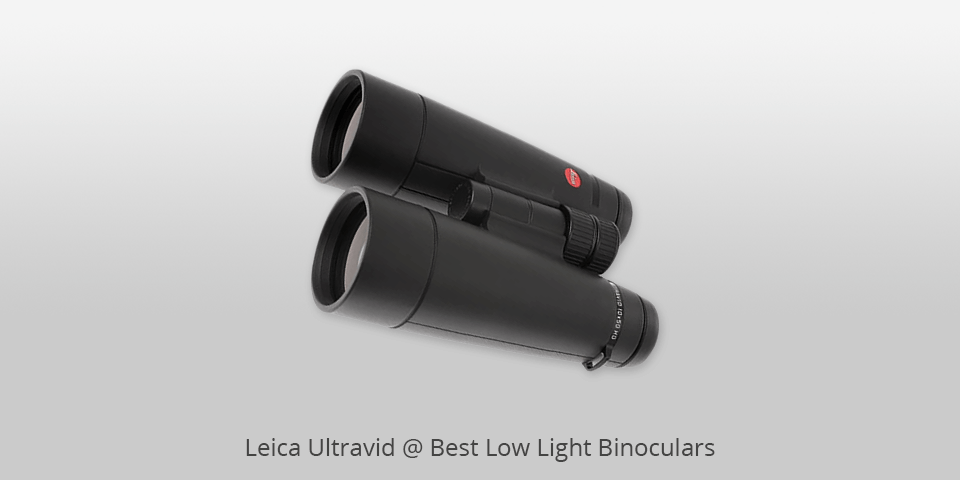
Magnification: 10x | Objective diameter: 50mm | Field of view at 1000m: 117 metres | Closest focusing distance: 3.25 m | Eye relief: 15mm | Weight: 2.60 pounds
⊕ Solid and convenient case
⊕ Have a wide field of view
⊕ Provide high transmission
⊕ Great whiteness rendition
⊖ Too high distortion
The Leica Ultravid 50 HD-Plus binoculars guarantee amazing contrast and very bright images. They have great detail resolution, accurate and reliable mechanisms.
Also, they boast new coating methods that deposit thin films of particular substances on the surfaces of the lens under ultra-high vacuum in a high-temperature plasma process.
The full-size 10x50 HD Plus provides great contrast and realistic color fidelity, practically without any distortion, even in conditions with low light. These low light binoculars offer high magnification, which makes it possible for you to see all the details. Also, due to a big exit pupil, they provide amazing viewing experience even in the dark.
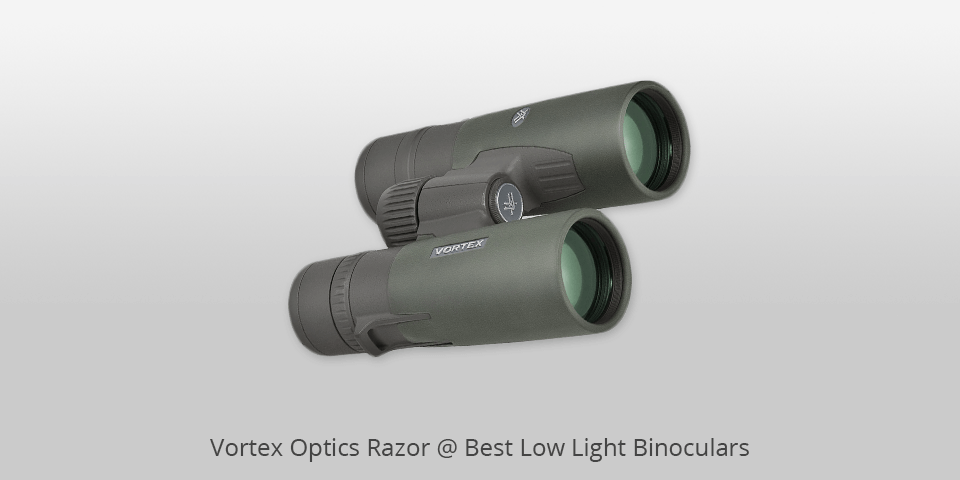
Magnification: 10x | Objective diameter: 42 mm | Field of view at 1000m: 448 ft | Closest focusing distance: 6 ft | Eye relief: 16.5 mm | Weight: 24.8 oz
⊕ Argon purged, O-ring sealed case
⊕ Qualitative high-density glass
⊕ Amazing anti-glare coatings
⊕ Durable armor
⊖ The twilight factor is low
These binoculars boast an amazing FOV that will be ideal for wildlife viewers, hunters and travelers. They have innovative anti-glare and ArmorTek coatings, which provide great optical quality.
These binoculars don’t weigh much and are small. Also, due to a non-slip design, you can use them in the worst conditions. Another advantage of these low light binoculars is their price.
You won’t have to invest too much money in them. With this model, you will achieve amazing optical experience and make your trips unforgettable.
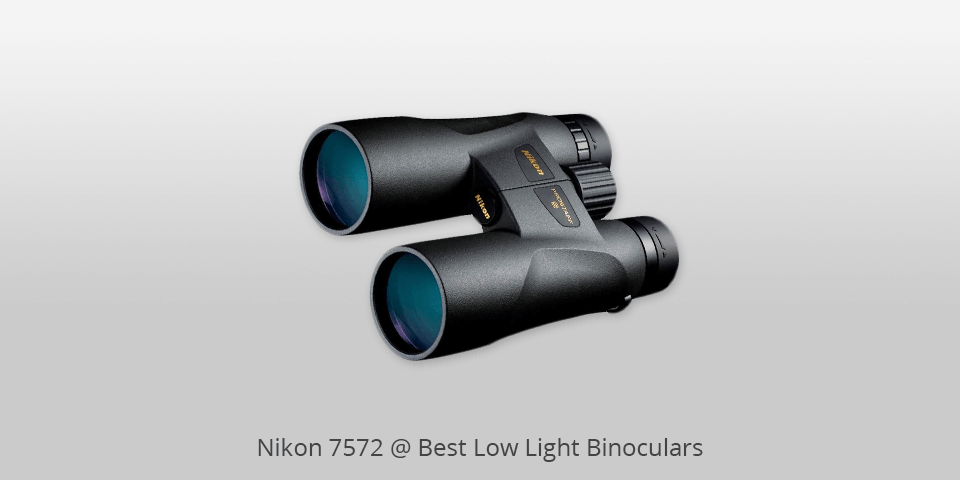
Magnification: 10x | Objective diameter: 42mm | Field of view at 1000m: 293 ft | Closest focusing distance: 16.4ft | Eye relief: 19.6mm | Weight: 28.7 oz
⊕ Seamless focus adjustments
⊕ Comes with a padded case and neck strap
⊕ Comfortable covering
⊖ Waterproof
⊖ Doesn’t have a threaded hole for monopod mounting
⊖ No case
Prostaff 5 binoculars are not only lightweight and provide great image quality in all hunting environments, but they also complement the lineup of Nikon products that excel in low light conditions. Nikon is well-regarded for its cameras, and the Nikon D850, considered the best low light camera available on the market, further enhances their reputation. The operational features are very simple to use.
It has a high-eyepoint design, which will help with a bright field of view even when you are in glasses, by keeping a particular space between your eyes and the eyepiece lens.
The turn-and-slide rubber eyecups will let you adjust the eye relief according to your wishes, providing a large field of view and extra comfort for long periods of use. The intuitive design of these binoculars will let you quickly focus on targets at a particular distance and spot the details.
These low light binoculars for hunting are waterproof and fog-proof due to the O-Ring.
| Image | Name | Features | |
|---|---|---|---|
 |
Zeiss Terra ED
Our Choice |
CHECK PRICE→ | |
 |
Bushnell Trophy
Budget |
CHECK PRICE → | |
 |
Swarovski SLC
Professional |
CHECK PRICE → |
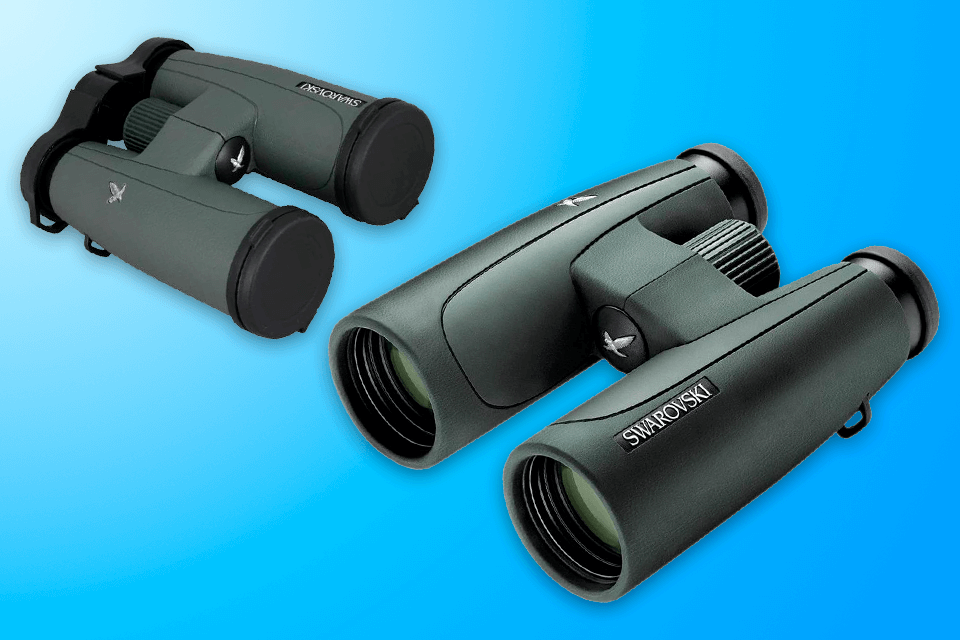
The purpose of binoculars is to enlarge the image. For low light binoculars, it is also important to increase the ambient light. However, remember that magnification can affect the amount of light that binoculars collect and hold.
It means that the larger the magnification is, the lower image brightness will be. That’s why, I suggest finding a balance between magnification and brightness. Try to stay away from high magnification binoculars when using them in a low light environment.
The diameter of the objective lens defines the effectiveness of binoculars in collecting and holding the light. The larger the diameter is, the wider the field of view will be.
Besides the field of view, brightness will be increased too as more light will enter binoculars. That’s why small and compact binoculars that have a small objective lens are not the best idea if you need to use them in low light conditions.
If the objective lens doesn’t have a good coating with several layers of anti-glare elements, a particular amount of the light will reflect from the glass and make the image less bright.
This happens because the light reflected before entering the objective lens is lost and won’t be able to create a bright image. Due to enhanced coating technologies, today’s binoculars can provide amazing light transmission. Besides, lens coatings protect the lenses from scratches and simplify their cleaning.
If the exit pupil is large, more light will pass through. The size of the exit pupil needs to match the dilation of our eye’s pupil. As our pupil dilates and changes its diameter with different light intensities, your binoculars need to have an exit pupil of around 5-7 millimeters wide. That’s how our eyes dilate in low light conditions.
The field of view means how much area of clear vision binoculars can provide at a 1000 yards. It’s a significant aspect that results in the quality of clear vision that low light binoculars provide.
When using binoculars in low light, such as during dawn or dusk, the available light is limited. A wider field of view enables you to scan a larger area without constantly readjusting your position. This can be especially important when observing fast-moving subjects or trying to locate specific targets in dimly lit environments.
Additionally, a broader field of view provides a more immersive experience, allowing you to feel more connected to the environment you’re observing. It enhances your ability to track moving objects and increases the chances of capturing unique moments in nature.
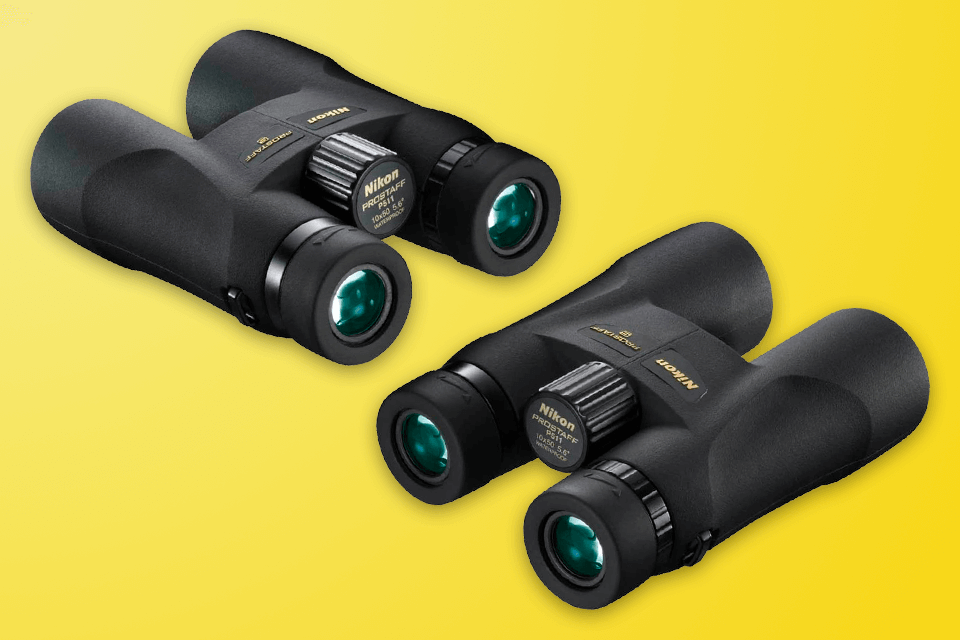
Binoculars are very important outdoor equipment, so they have to be waterproof. Such binoculars will allow you to use them even in the worst weather conditions. Also, they need to be fog-proof to provide you with a clear vision.
The more light, the more information. Therefore, if everything else is the same, there is the potential for brighter and better viewing quality with 10x50 binoculars compared with 10x42 binoculars. However, just the ability to capture more light doesn’t guarantee a brighter and better image.
The Twilight Factor is a mathematical formula that shows how lens size and magnification contribute to the ability of binoculars to show details in dim light. The Twilight Factor is the square root of the lens diameter and the magnifying power of binoculars.
As for optics, the glass in low-cost binoculars used for lenses and prisms has a worse quality and has more bubbles and defects than more qualitative (and more expensive) optical glass, which is used for more expensive binoculars.
Relative Brightness means the comparison of the brightness of two objects. You can do it using a particular mathematical equation or just looking at them and judging. It’s used as a term to compare binoculars too.

 Rating
Rating